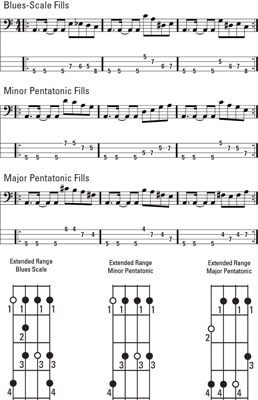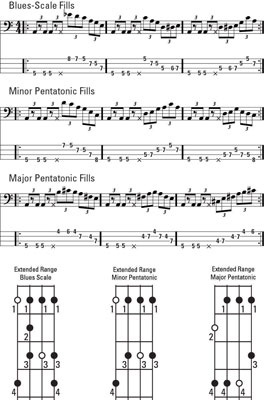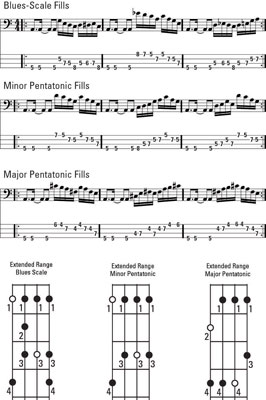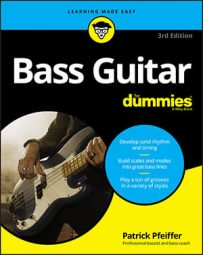Fills are mini-solos that give bass guitar grooves a little flash every now and then. It gives the bass guitarist a little bit of variety and individuality. The purpose of the fill is to
Lead you back to the beginning of the groove
Give your line (the bass part you’re playing) some variety
Fill a little space when the rest of the band is quiet
A fill works the same way as a solo: You use the minor pentatonic scale as a fill when playing a minor chord, the major pentatonic scale as a fill when playing a major or dominant chord, and the blues scale as a fill when playing any chord.
A fill is usually short (only about two to four beats long), so you need to fit the notes of the fill within the allotted beats and blend them smoothly with the other notes.
Connect your fill to the groove
You can take more liberties in terms of rhythm with a solo than you can with a fill. When fills are a part of the groove, the rhythm for the fill has to relate closely to the rhythm of the groove.
When you put a fill into a groove, you need to be acutely aware of the number of beats you have to fill before returning to the beginning of the groove. You can’t miss the beginning of a groove — not even for the greatest of fills.
How to time a fill
Most of the time a fill within a groove lasts for about two beats — the last two beats of a measure. In other words, you play beats 1 and 2 (the first two beats of the measure) as a regular groove, and then you replace beats 3 and 4 (the last part of your groove) with a fill.
Don’t play a fill every time you play a groove, because it will obscure the groove, which is the sound the band depends on to guide them in rhythm and harmony. A fill is usually only played every fourth measure or every eighth measure.
The following list guides you step by step through the process of creating a fill.
Establish a groove.
Determine where the third beat starts in your groove.
Because you’ll be substituting your fill for beats 3 and 4, play the groove up to the third beat.
Determine how many notes you can hit in the two beats (beats 3 and 4).
The two beats for the fill have a total of four eighth notes, six triplets, or eight sixteenth notes. A lot depends on the tempo of the groove and on how accurately you can fit the notes into the two beats of the fill before the first note of the next groove. You can fit more notes into a fill at slower tempos.
Work out a fill, paying attention to the number of notes you can play, and using the appropriate pentatonic or blues scale for the chord of the groove.
Practice going back and forth between the groove and the fill until your transitions are seamless.
To create a successful fill, your groove must flow without hesitation, leading into the next groove seamlessly and on time.
Play your fill no more than every four or eight bars so that each fill sounds special.
If you play your fill more often than every four or eight bars, it will just sound like another groove.
Here are examples of two-beat fills. You can also see the fills played in Chapter 7, Video Clip 19. All the fills have different subdivisions: The first group in Chapter 7, Audio Track 54 subdivides the beat into eighth notes, the next in Chapter 7, Audio Track 55 subdivides the beat into triplets, and the last in Chapter 7, Audio Track 56 subdivides the beat into sixteenth notes. Each group includes first the blues scale for the fill, then the minor pentatonic, and last but not least the major pentatonic.
To make the exercise more realistic, it begins with a whole measure of a groove followed by the first two beats of the same groove and then immediately by the fill in the last two beats, just the way you would play it in a song.
When you feel comfortable playing the fills, incorporate them into some of your more complex grooves. You also can create a collection of your own favorite fills and incorporate them into your playing. Here is a groove with an eighth-note fill.

Here is a triplet fill.

And finally, here is a groove with a sixteenth-note fill.


